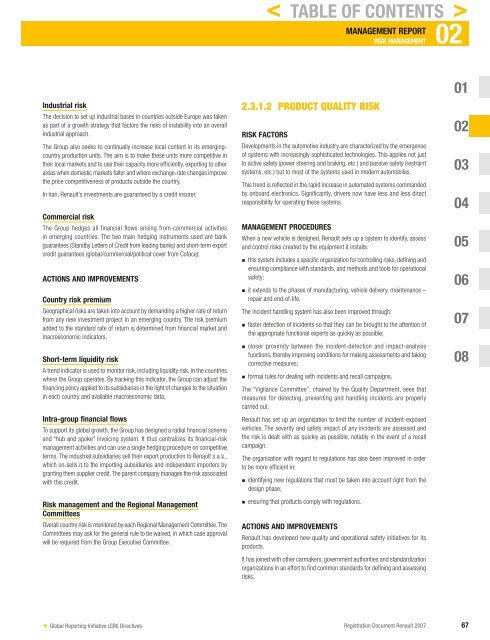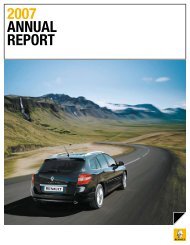2007 Interactive Registration Document - Renault
2007 Interactive Registration Document - Renault
2007 Interactive Registration Document - Renault
You also want an ePaper? Increase the reach of your titles
YUMPU automatically turns print PDFs into web optimized ePapers that Google loves.
Industrial risk<br />
The decision to set up industrial bases in countries outside Europe was taken<br />
as part of a growth strategy that factors the risks of instability into an overall<br />
industrial approach.<br />
The Group also seeks to continually increase local content in its emergingcountry<br />
production units. The aim is to make these units more competitive in<br />
their local markets and to use their capacity more effi ciently, exporting to other<br />
areas when domestic markets falter and where exchange-rate changes improve<br />
the price competitiveness of products outside the country.<br />
In Iran, <strong>Renault</strong>’s investments are guaranteed by a credit insurer.<br />
Commercial risk<br />
The Group hedges all financial flows arising from commercial activities<br />
in emerging countries. The two main hedging instruments used are bank<br />
guarantees (Standby Letters of Credit from leading banks) and short-term export<br />
credit guarantees (global/commercial/political cover from Coface).<br />
ACTIONS AND IMPROVEMENTS<br />
Country risk premium<br />
Geographical risks are taken into account by demanding a higher rate of return<br />
from any new investment project in an emerging country. The risk premium<br />
added to the standard rate of return is determined from fi nancial market and<br />
macroeconomic indicators.<br />
Short-term liquidity risk<br />
A trend indicator is used to monitor risk, including liquidity risk, in the countries<br />
where the Group operates. By tracking this indicator, the Group can adjust the<br />
fi nancing policy applied to its subsidiaries in the light of changes to the situation<br />
in each country and available macroeconomic data.<br />
Intra-group financial flows<br />
To support its global growth, the Group has designed a radial fi nancial scheme<br />
and “hub and spoke” invoicing system. It thus centralizes its fi nancial-risk<br />
management activities and can use a single hedging procedure on competitive<br />
terms. The industrial subsidiaries sell their export production to <strong>Renault</strong> s.a.s.,<br />
which on-sells it to the importing subsidiaries and independent importers by<br />
granting them supplier credit. The parent company manages the risk associated<br />
with this credit.<br />
Risk management and the Regional Management<br />
Committees<br />
Overall country risk is monitored by each Regional Management Committee. The<br />
Committees may ask for the general rule to be waived, in which case approval<br />
will be required from the Group Executive Committee.<br />
✦ Global Reporting Initiative (GRI) Directives<br />
2.3.1.2 PRODUCT QUALITY RISK<br />
MANAGEMENT REPORT 02<br />
RISK MANAGEMENT<br />
RISK FACTORS<br />
Developments in the automotive industry are characterized by the emergence<br />
of systems with increasingly sophisticated technologies. This applies not just<br />
to active safety (power steering and braking, etc.) and passive safety (restraint<br />
systems, etc.) but to most of the systems used in modern automobiles.<br />
This trend is refl ected in the rapid increase in automated systems commanded<br />
by onboard electronics. Signifi cantly, drivers now have less and less direct<br />
responsibility for operating these systems.<br />
MANAGEMENT PROCEDURES<br />
When a new vehicle is designed, <strong>Renault</strong> sets up a system to identify, assess<br />
and control risks created by the equipment it installs:<br />
n<br />
n<br />
this system includes a specifi c organization for controlling risks, defi ning and<br />
ensuring compliance with standards, and methods and tools for operational<br />
safety;<br />
it extends to the phases of manufacturing, vehicle delivery, maintenance –<br />
repair and end-of-life.<br />
The incident handling system has also been improved through:<br />
n<br />
n<br />
n<br />
faster detection of incidents so that they can be brought to the attention of<br />
the appropriate functional experts as quickly as possible;<br />
closer proximity between the incident-detection and impact-analysis<br />
functions, thereby improving conditions for making assessments and taking<br />
corrective measures;<br />
formal rules for dealing with incidents and recall campaigns.<br />
The “Vigilance Committee”, chaired by the Quality Department, sees that<br />
measures for detecting, preventing and handling incidents are properly<br />
carried out.<br />
<strong>Renault</strong> has set up an organization to limit the number of incident-exposed<br />
vehicles. The severity and safety impact of any incidents are assessed and<br />
the risk is dealt with as quickly as possible, notably in the event of a recall<br />
campaign.<br />
The organization with regard to regulations has also been improved in order<br />
to be more effi cient in:<br />
n<br />
n<br />
< TABLE OF CONTENTS ><br />
identifying new regulations that must be taken into account right from the<br />
design phase;<br />
ensuring that products comply with regulations.<br />
ACTIONS AND IMPROVEMENTS<br />
<strong>Renault</strong> has developed new quality and operational safety initiatives for its<br />
products.<br />
It has joined with other carmakers, government authorities and standardization<br />
organizations in an effort to fi nd common standards for defi ning and assessing<br />
risks.<br />
01<br />
02<br />
03<br />
04<br />
05<br />
06<br />
07<br />
08<br />
<strong>Registration</strong> <strong>Document</strong> <strong>Renault</strong> <strong>2007</strong> 67




